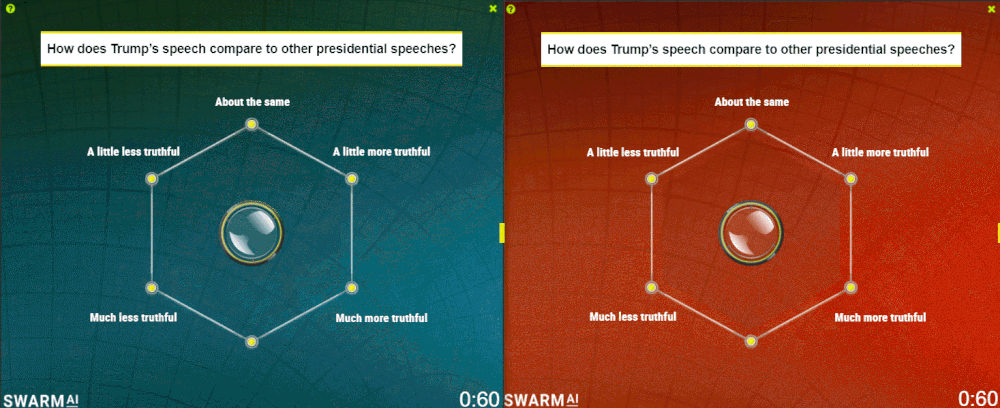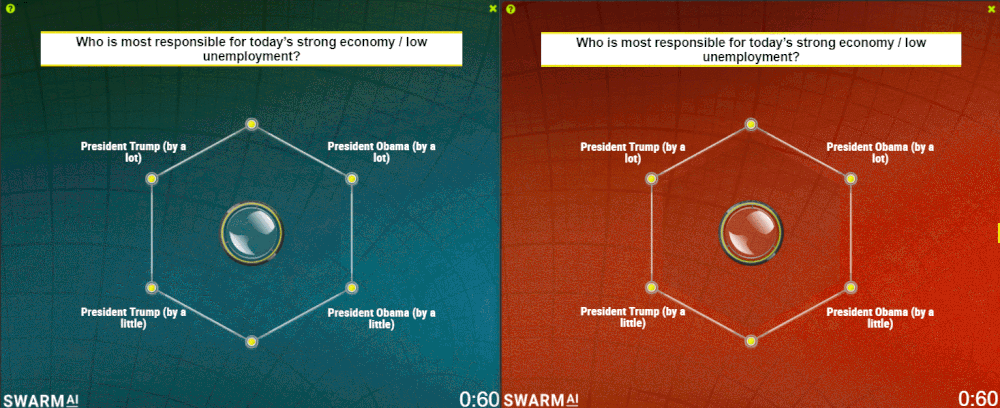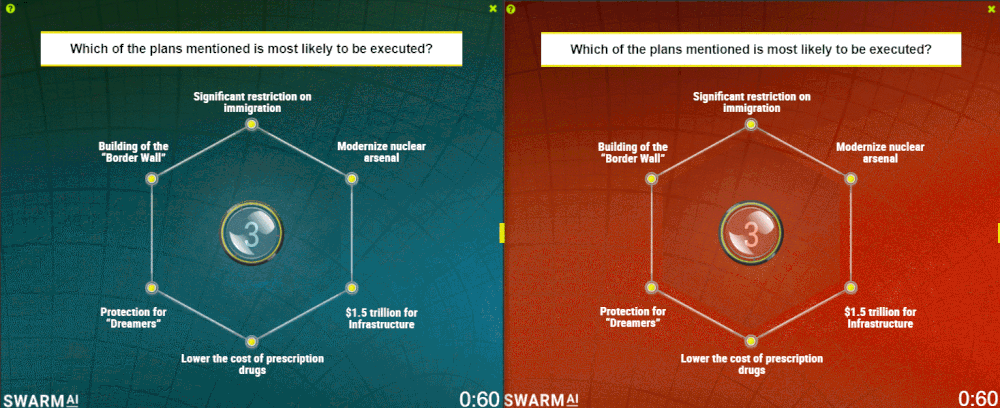AI INSIGHT INTO TRUMP’S STATE OF THE UNION ADDRESS
On Tuesday, Donald Trump delivered his first State of the Union address, a call for bipartisanship and unity at a time when many believe that the country is very much divided. Response to the speech largely fell along party lines, with Fox News praising Trump for offering an “open hand” to Democrats, while the Guardian wrote that “it was a night when he could pretend to be the president he never is.” But researchers at Unanimous AI wanted to move beyond these seemingly preordained reactions, and tap into the collective of intelligence of voters on both sides of the aisle to see what their Swarm AI technology would reveal about the response to Trump’s speech.
The morning after the State of the Union, Unanimous researchers convened two swarms of American voters. One of these swarms was composed entirely of people who had voted for Hillary Clinton for president in 2016, the other entirely of Trump voters. Both swarms were asked the same set of questions about Trump’s State of the Union address and, working together as a Swarm AI system, both groups combined their wisdom, intuition, and experience to converge upon answers that best reflected their group’s collective will. This research will show where those groups diverged and converged in reaction to the same stimulus.
First, in the immediate wake of the president’s speech, Unanimous AI researchers asked both groups to evaluate its truthfulness in comparison to previous State of the Union speeches. Naturally, FactCheck.org drilled down on all of the statistics on offer during Trump’s speech, but Unanimous researchers were looking for something a little different. They wanted to see how Clinton and Trump voters perceived the president’s address, an important indication of support for the candidate, and the replay below shows where those groups differed in their interpretations. The swarm on the left is composed of Clinton voters, and the red swarm on the right shows how Trump voters converged on their answer.

As you can see in this side-by-side replay, the Clinton voters quickly converged on “much less truthful” while the Trump voters were just as quick to label the speech “a little more truthful” than Trump’s predecessors. This sort of response shows that Trump has done very little to win over Clinton supporters in his first year in office, despite his pleas for unity in the address. On the other hand, that Trump voters may have converged rapidly, but in opting for “a little more truthful” rather than “much more” their was slightly less confident.
Researchers saw a similar divergence, but with equally confident responses, when they asked the two swarms to assign credit for the booming American economy, which drew positive headlines throughout 2017. But, while the president was happy to attribute that record growth to a combination of his policies and surging consumer confidence, his detractors would argue that the past year’s economic successes are the product of Barack Obama’s policies. This disparity is on full display in the pair of replays below.

While it may seem that the Clinton and Trump swarms reflect a hopelessly divided nation, the research doesn’t support that claim. In fact, both groups believe that potential Russian interference was the most notable issue absent from the State of the Union, and that the president’s tax reform bill will increase the budget deficit ( though they disagree on the amplitude of that change). But perhaps most tellingly, both Clinton and Trump voters revealed the belief that “significant restriction on immigration” is the most likely to be enacted of all plans mentioned in the State of the Union.

Immigration reform has been Donald Trump’s central promise since literally Day One of his campaign, when he famously promised to “build a wall” between the United States and Mexico. Years later, as President of the United States, Trump devoted a large portion of his first State of the Union address to justifying his intention to carry out that campaign pledge, and research produced by Unanimous reveals that, whether they like it or not, both sides of the aisle now trust Trump to deliver on that promise. But, here again, the swarms disagreed on the likelihood of the wall itself being built, with Clinton voters forecasting its chances at under 10%, while Trump voters were more confident at 20%.
These are just three examples of the questions posed by Unanimous researchers of the Trump and Clinton swarms. The full comparison of these two swarms’ responses are available in the chart below. Taken as a whole, these insights paint a picture of a divided – but not irreparable – electorate.

Unanimous will be fielding swarms throughout 2018 to track the sentiment of the American public and to identify the trends and behaviors that are shaping our future. If you would like to stay informed of our research, sign up below.
Want to learn more about our Swarm AI technology? Check out our TED talk below…


